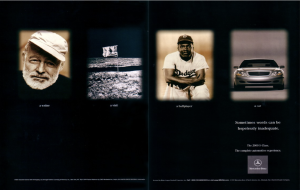Food for thought.
- Advertising has its own unique language
- Ad language includes unique terms and acronyms
- Being able to speak the language can help you succeed in advertising
Let’s start at the beginning.
What is Advertising? Advertising is:
- A marketing communication tool
- A message used to persuade or motivate
- A way to build brand awareness and differentiation
- A way to deliver information, promote charitable cause, political ideas, and social and economic development
NOTE: Advertising is NOT only about selling.
The primary vehicles of mass communication through advertising are:
- Print/2D (static)
- Broadcast (time-based) because it moves you through a story over time
- Digital
- Other media (alternative media, experiential)
Why the emphasis on print in this class? Because:
- Print is the conceptual bedrock of advertising.
- Print is pure. It doesn’t dance or sing – except in your mind.
- In print, a concept has nothing to hide behind. No fancy lighting, great music, an amazing location, or great acting. If your idea depends on production values, it’s not an idea.
- At its best, print has the power to stop and hold a gaze.
- Print is the perfect teaching tool because it lays your ideas (or lack thereof) bare.
- If your idea is compelling in print, there’s a good chance it can be extended into other media.
Let’s look at some examples of print ads, which appear in paper and ink in magazines, newspapers, transit posters, wild postings, billboards. A print ad has to communicate everything on the page.
Let’s look at a few ads – for two different kinds of mineral water.
In the first Pellegrino ad below, a couple is dancing and having the time of their lives. In the second ad, another couple is also having a great time – so much so they’ve lost track of time. In both ads, the headline is: “It must be the water”.


In this Evian ad, we see a woman pouring Evian into a fishbowl where a goldfish is swimming around. We all know that fish need really pure, clean water in order to survive. And the headline is “l’original” – the original. The implication is: what could be purer than the original water, from a mountain spring.

Next, let’s look at a 2-page ad, which is also known as a spread. It takes up two facing pages so that when the magazine is open, it looks like one large, connected ad. What do we see? A few images of Hemingway, of the American flag on the moon, of Jackie Robinson and of a Mercedes Benz. And the captions say “A writer. A flag. A ballplayer. A car”. Now we know very well that these four things are much more than the captions make them out to be.

The headline is: Sometimes words can be hopelessly inadequate.
What’s the point this ad is trying to make? That calling a Mercedes a car is like calling Hemingway a mere writer or Jackie Robinson just another ballplayer. In other words, there are cars and then are Mercedes.
Let’s look at a billboard, which can be on the side of the highway or a transit ad. Either free-standng or on walls. In subway stations, highways, etc. This particular ad happens to be unusual because the headline is also the tagline. A very famous tagline for a long-running, famous campaign by the Milk Advisory Board. The headline is “got milk” because a glass of milk would be the perfect thing to have with these cupcakes.

Other famous taglines include:
A diamond is forever (DeBeers)* sidebar about why when you get engaged, you expect to be presented with a diamond ring
Be all you can be (The Army)
The word “Tagline” is also part of the language of advertising. It’s important to understand what someone means when they say “Tagline”. A tagline is not a headline that’s placed somewhere else on the ad. I’ve mentioned in passing that a tagline is like a hashtag. In the next chapter, we’ll talk more about taglines. What they are. How long they should be. And how to write them.
But for now, it’s good to note that a Tagline:
- Is an enduring catchphrase/slogan that positions the company and/or product
- Distills and captures the essence of the brand and/or product
- Should be able to stand alone
- Can also be used together with visuals
- Is purely verbal/text
Add Key Takeaways
